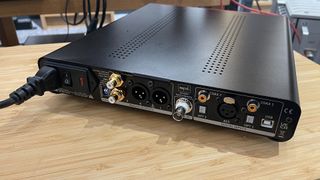Why would you need a dedicated headphone amplifier like SPL’s Phonitor SE? The obvious answer is that it adds headphone connectivity to a system that doesn’t have any. Simply plug your source into the SPL unit’s only input and your headphones into the front panel 6.3mm socket, and off you go.
Features

As standard, the SPL Phonitor SE is an all-analogue device, but for £400 / $400 / AU$700 extra it is available with a DAC module, which adds compatibility with up to 32-bit/768kHz PCM hi-res music files and DSD256. This digital board features USB (Type B), coax and optical inputs. We have previous experience with this DAC circuit and can confirm that it is a good one, being competitive with the top outboard number crunchers available for similar money.
SPL Phonitor SE tech specs
Type Headphone amplifier
Inputs Stereo RCA x 1
Output 6.3mm
Max file support 32-bit/768kHz PCM, DSD256
DAC Optional
Dimensions (hwd) 57 x 278 x 300mm
Weight 2.8kg
Our review sample of the Phonitor SE is the basic analogue-only unit, but you will still find the (redundant) switches for the DAC module on the front panel. Look past those and there is little to report bar the volume control and a three-option crossfeed toggle. What is crossfeed? It is an attempt to bring the headphone listening experience closer to that of speakers by feeding some of the signal from the left channel into the right and vice versa. The idea is that this processing moves the soundstage from being in between your ears, as in conventional headphones, to more in front of you. We generally like the effect and end up leaving the unit on the second of the crossfeed options, C2, on most recordings.
Build
The Phonitor SE is a beautifully built unit. It feels solid and durable from the nicely finished casework to the smooth volume control and front panel switches. It is available in three standard front panel colour options – red, silver and black – with the rest of the casework painted black. Take a look inside and you are in for a treat. The engineers clearly took pride in their work; the circuit is neatly laid out and packed with good-quality components. The technical highlight is that the circuitry operates at a much higher voltage level than is conventional, which should benefit the noise performance and dynamic punch. The claimed power output through the headphone socket is 2 x 5 watts, which is beefy for a product like this.
Overall, there is no mistaking the functional aura around the Phonitor SE; it is very much designed as a workhorse rather than something to show off about. We suspect that is borne of the brand’s strong connection to the Pro world.
Compatibility
Given the SPL’s price, don’t be tempted to skimp on the source or partnering headphone quality. If you do that, you might as well go for one of the many cheaper alternatives on the market. Suitable sources would be along the lines of Naim’s ND5 XS2 music streamer and Cyrus’s CDi CD player, while appropriate wired headphones include Focal’s Clear Mg and Sennheiser’s HD800S right up to the likes of Grado’s GS300x, Austrian Audio’s The Composer and even the high-end Yamaha YH5000SE.
This is the third product we have reviewed from SPL and we are impressed by the consistency of its output. All three products (the others are the Diamond DAC and the Phonitor xe) share a sonic signature, and we like it a lot. It is about clarity, control and tonal evenness.
Sound
Listen to a complex piece of music such as Mahler’s Symphony No.3 and Phonitor SE will render the sound with a wonderful sense of calm. It never sounds stressed or as though it is struggling to keep a grip on the various instrumental strands. This sense of composure allows the listener to relax into the musical experience, confident that the amplifier is in charge. Sometimes such composure comes at the expense of excitement, which we initially worried about. But over time, it becomes clear that this SPL has the dynamic chops and muscularity to render the music’s drama properly. It takes the honest approach, preferring to let the music do the entertaining rather than trying to add a bit of spice itself.
As the Mahler symphony builds we note the pleasing sense of space in the Phonitor’s presentation and its ability to avoid sounding cluttered. It helps that details are crisply rendered with little in the way of blur or vagueness when it comes to defining the leading edges of notes. This is particularly praiseworthy at low frequencies where the SPL delivers exceptional grip without sacrificing tunefulness.
That same bass quality works wonderfully with Massive Attack’s Heligoland set. Here, the SPL headphone amp delivers bass with considerable conviction, thumping it out with punch and power. Move up the frequency range and you will find that the midrange is crisp and clean while retaining the natural warmth of vocals. We are pleased to report that the Phonitor SE is the kind of product that you can listen to for hours on end without issue. For all its insight and resolution, it avoids sounding hard-edged and sterile. Feed it a poor or aggressive recording, we used Bruce Springsteen’s heartfelt Terry’s Songand the SPL refuses to make a meal of things. It is highly revealing of the recording’s shortcomings but never goes out of its way to be rude.
Verdict
If you are seriously into headphones then we highly recommend that you have a listen to the SPL Phonitor SE. It is a hugely accomplished product that ticks all the boxes as far as we are concerned. Given a good enough partnering system, this is a product that shines.
SCORES
MORE:
What is a headphone amplifier and why should you buy one?
Check out our Chord Hugo 2 review
Our pick of the best headphone amplifiers you can buy right now

